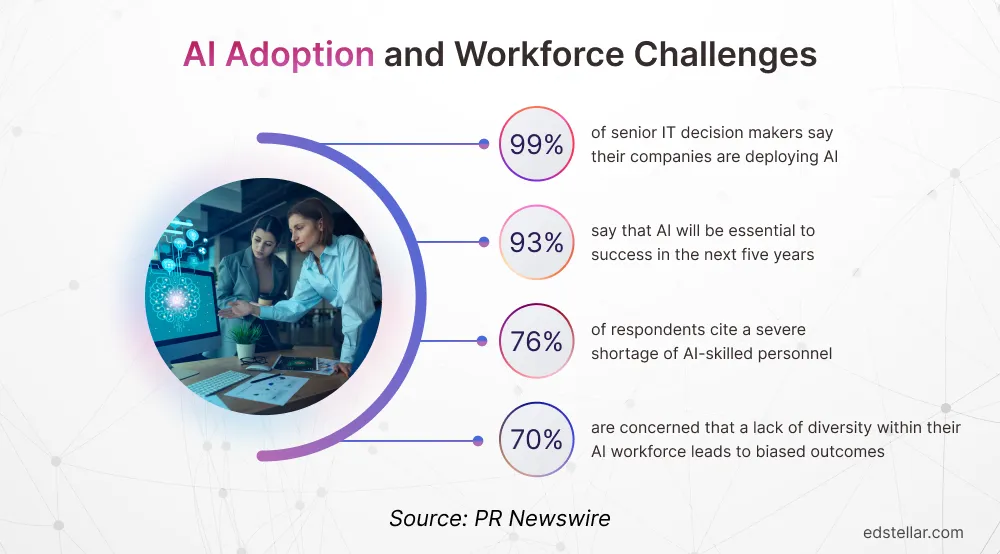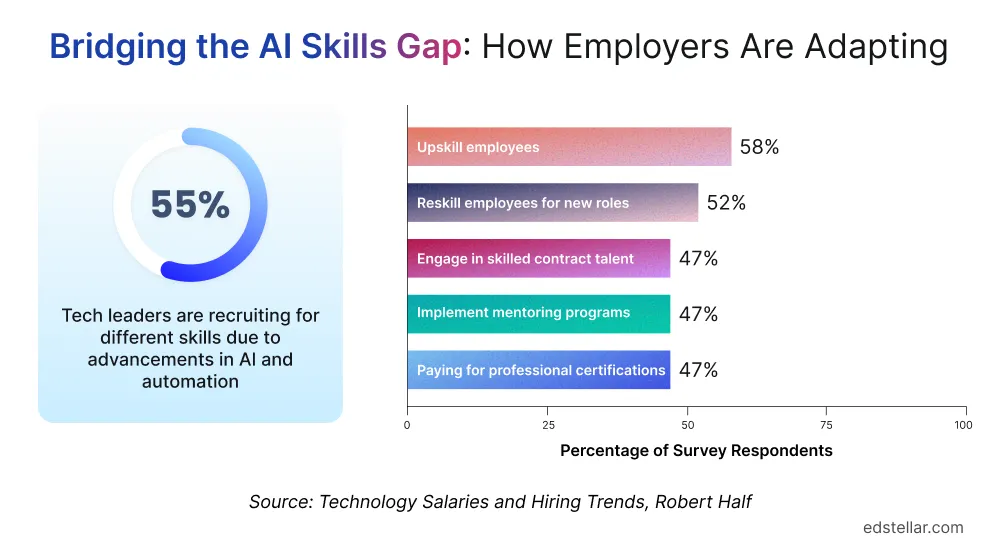
The AI wave has hit, and it’s only gaining speed. From generative models to enterprise automation, artificial intelligence is already reshaping how businesses operate. McKinsey estimates that AI can contribute a value of $4.4 trillion in productivity improvement, and 92% of companies plan to increase their AI investments in the next three years. Yet, only 1% consider themselves truly mature in AI deployment.
Despite the momentum, most organizations remain stuck in early-stage deployment. Pilots fail to scale, business outcomes are inconsistent, and many teams operate without a clear AI adoption roadmap. While leaders invest capital, they often lack clarity on where value will come from, or how to translate AI into everyday workflows. The challenge ahead isn’t just technological, it’s organizational. Without the right skills, structures, and learning pathways in place, AI strategies risk stalling before they deliver impact.
Employees are already engaging with AI tools often more actively than their leaders realize. Many are ready to adopt new ways of working and are asking for training, support, and clarity. This readiness signals momentum, but it needs direction.
With teams eager to adopt AI and skill gaps becoming more visible, leadership pressure is mounting. But knowing where to start is often the hardest part. Which roles need what kind of training? What skills matter most at this stage of AI maturity? And how do you ensure training leads to real, strategic capability, not just activity? Without clear direction, even the most ambitious AI initiatives risk stalling at the first step.
In this blog, we explore why AI training needs vary across organizations and what it takes to get them right. From identifying skill gaps to finding the right trainers, each step matters in the journey. Read on to find out.
Why AI Training Needs Vary Widely Between Organizations
AI training needs differ widely across industries, functions, and maturity levels.
According to a McKinsey report, sectors like technology, healthcare, and telecom are racing ahead in AI investments and integration, while consumer goods, retail, energy, materials, financial services, and public sectors lag behind. Within organizations, roles in marketing, R&D, and operations often wield high AI value potential but are underserved by generic training programs.

Adding to this complexity is the uneven pace of AI adoption across different types of use cases. According to a McKinsey report on AI agents adoption, horizontal applications like chatbots and copilots are being widely rolled out to boost individual productivity, their impact is often shallow and dispersed. In contrast, high-impact vertical use cases, embedded within critical business processes, struggle to scale despite their economic potential.
To close this gap, organizations must identify their most business-critical AI opportunities and prioritize training accordingly, ensuring teams build the specific capabilities required to drive meaningful adoption and measurable outcomes.
Many teams are already using AI informally and actively seeking structured training, but the support they receive is inconsistent. While some organizations offer robust onboarding and pilot programs, others leave employees to navigate AI adoption alone, often without clear direction or role-specific guidance. This uneven support reveals a leadership gap and reinforces the need for training strategies that are tailored to teams' specific contexts, roles, and use cases, not generic programs that assume one-size-fits-all.
Before Getting to Training: Map Your Team’s AI Skilling Needs
Before you jump into training, it’s crucial to understand what you're training for. Generative AI is reshaping not just how work is done, but what work needs to be done, and by whom. According to McKinsey, gen AI could automate up to half of today’s work activities between 2030 and 2060. This shift isn’t one that companies can simply hire their way out of. To truly harness AI’s potential, organizations must map their unique talent and capability gaps, aligning learning strategies with evolving roles, functions, and business priorities.

- Mapping AI Capabilities to Business Goals: Many companies begin by offering basic tool training, prompt writing, chatbot usage, or platform demos. While helpful, this misses the deeper shift underway. AI is changing how work is structured and where human value lies. As Deloitte points out, organizations that only focus on automation for efficiency will likely limit long-term gains.
In contrast, those that retrain employees to take on higher-value, judgment-based tasks can unlock broader business impact. That’s why capability mapping must go beyond software use and center on the outcomes your teams are expected to deliver in an AI-enabled environment.
To do this effectively, organizations should involve a cross-functional team, including L&D leaders, business unit heads, and workforce strategists, to identify business-critical outcomes and the capabilities required to achieve them. This means assessing how AI will reshape core workflows, what skills will remain essential, and where new proficiencies, such as data interpretation, cross-functional collaboration, or ethical decision-making, must be developed. Capability mapping at this level shifts training from a support activity to a transformation enabler, directly aligned with strategic goals.
- Segment AI Training Needs by Role Type: Once you’ve identified the business outcomes and capabilities required in an AI-enabled environment, the next step is to segment those needs by role type. Not every team needs to become AI engineers, but nearly every role will need to adapt in some way.
Start by grouping roles into three categories:
Segmenting roles this way allows organizations to design tiered learning journeys, ensuring each role gets training that’s practical, relevant, and aligned to its impact on AI transformation.
This segmentation also helps avoid two common pitfalls: undertraining business users who need fluency to make AI work in real life, and overtraining roles with limited AI exposure. When skilling reflects how roles contribute to business goals, adoption becomes both scalable and sustainable.
- Align Training Topics to Skill Readiness Levels: Once roles are segmented, the next step is to assess how deep the training needs to go. Not everyone needs advanced AI expertise, but everyone engaging with AI needs the right level of understanding to contribute confidently.
Use a tiered skill readiness framework to align training depth with learner maturity:
This structure helps avoid both undertraining and overtraining. For example, an HR team may need applied-level training in prompt engineering and data interpretation, while a machine learning engineer needs advanced-level exposure to model fine-tuning or deployment pipelines.
Mapping training topics this way ensures your programs stay relevant, targeted, and outcome-driven maximizing adoption and minimizing confusion.
- Prioritize Capability Gaps That Unlock Business Value: Not every team needs AI training all at once. Once you’ve mapped skill needs by role and readiness level, the next step is to prioritize. Focus first on areas where capability gaps are actively holding back strategic initiatives or where the value upside is highest.
This means asking two key questions:
- Where is lack of AI capability delaying progress or creating inefficiencies?
- Which roles or functions, if trained, can directly accelerate high-value use cases or unlock measurable ROI?
Training efforts should start where both urgency and impact intersect. For example, upskilling product teams in prompt engineering might unblock a stalled gen AI pilot, or training your HR operations team could reduce internal service tickets with an AI chatbot.
By taking a prioritization-first approach, organizations avoid spreading training too thin. Instead, they create early success stories that drive adoption and demonstrate tangible business impact, paving the way for wider, scalable AI learning programs.
What Makes Great AI Trainers Truly Stand Out
While many professionals can deliver AI tool training, only a select few possess the depth and strategic insight to truly transform how teams think, operate, and create value with AI. Great AI trainers help teams shift from rigid workflows and knowledge silos to adaptive, AI-supported ways of working, where tasks are automated where possible, decisions are made with richer data, and every role is empowered to contribute to innovation.
1. They Anchor Training to Business-Critical Use Cases
Great AI trainers don’t start by showcasing tools, they start by asking what matters most to the business. Before designing any curriculum, they work with stakeholders to identify where AI can solve high-impact problems or unlock efficiency.
This could be improving turnaround time in customer service, simplifying compliance documentation, or enabling faster decision-making in R&D. By grounding training in these real-world use cases, they ensure that learners engage deeply because they see the direct link between what they’re learning and the outcomes they’re expected to deliver.
2. They Translate Strategy into Role-Based Capability
Great AI trainers do more than deliver information, they help organizations turn AI ambition into executable learning pathways. Once business objectives are defined, they engage with stakeholders across functions to break those down into the specific skills, behaviors, and mindsets required at different levels of the organization.
This translation is not simple. It requires the trainer to understand how AI initiatives (like automating internal workflows or embedding GenAI in product development) map to real roles, be it frontline customer support, R&D, or operations. Through structured discovery workshops, interviews, and workflow analysis, they help identify what each group actually needs to learn, not just about the AI tools, but about how to apply them responsibly and effectively in their own work context.
Their strength lies in bridging the language of strategy with the realities of work. Instead of handing over a one-size-fits-all curriculum, they create role-specific training objectives, learning outcomes, and assessments, ensuring that every learner knows not just what to do with AI, but why it matters in their function. This ability to contextualize strategy into skill-building is what elevates good training to organizational transformation.
3. They Tailor Learning to Workflows
Great AI trainers don’t deliver generic sessions, they design training that fits how different roles operate day to day. They dig into what each function actually does and shape learning around the specific tasks, decisions, and tools people use.
A product manager exploring GenAI for feature ideation doesn’t need the same journey as a finance analyst validating forecasts or a customer service lead using AI to triage tickets. By designing exercises and prompts that reflect real workflows, inside CRM systems, spreadsheets, or project boards, they make learning intuitive, immediately relevant, and deeply actionable.
This role-specific lens ensures AI skills are not learned in isolation, but as accelerators for the work people already do.
4. They Adapt Training to Industry Context
AI in healthcare is not AI in manufacturing. Great trainers go beyond job roles to consider the industry-specific requirements that shape how AI can be applied safely and effectively.
To do this, they focus on specific domains, understanding that each industry presents its own set of challenges and opportunities. Whether it's compliance and patient data protection in pharma, real-time throughput constraints in manufacturing, or customer privacy concerns in finance, trainers adapt the training to fit the context. Their examples, scenarios, and guardrails are tailored to reflect the domain, not just the function.
By embedding domain relevance into their training, AI trainers ensure teams aren't just learning AI; they're learning how to apply it effectively within the business environment they operate in every day.
5. They Design Content to Match Skill Levels
Not everyone needs to learn advanced ML models, and great AI trainers know that. They design differentiated learning paths based on the audience’s current capability and the sophistication needed for their work.
For some, that means foundational AI literacy: how GenAI works, where to trust it, and how to craft effective prompts. For others, it’s applied use cases like automating documentation or analyzing customer sentiment. For technical teams or R&D, it may go deeper into model fine-tuning, data pipelines, or risk mitigation strategies.
By offering the right depth to the right people, they avoid overwhelm, accelerate learning, and ensure that AI skills are not just taught, but retained and used well.
6. They Come Up with Learning Experiences That Stick
Great AI trainers don’t rely on slides and lectures, they bring learning to life. They draw from a wide spectrum of evidence-based practices to ensure knowledge sticks and skills transfer beyond the session.
That means embedding microlearning nudges, in-app prompts, and just-in-time quizzes to reinforce concepts exactly when teams need them. It means designing hands-on labs, real-world simulations, and decision-making scenarios that mirror everyday challenges. And it means enabling peer-led mentoring, reflection cycles, and follow-up touchpoints to sustain learning momentum.
Their strength lies not just in what they teach, but in how they design experiences that people remember, apply, and build on. That’s what turns a training into transformation.
7. They Embed Responsible Use in Every Lesson
AI training isn’t just about generating outputs, it’s about understanding limitations, biases, and the ethics of modeling. Top trainers weave decision-making scenarios, such as identifying hallucinations, handling sensitive data, or mitigating bias, into foundational modules. They guide learners through cases that expose the ambiguity of AI output and invite reflection. This shifts participants from passive tool users to critical, trustworthy AI practitioners.
In a world where AI tools are evolving faster than regulations, it’s not just about capability, it’s about accountability. And great trainers ensure your teams are ready for both.
What Sets Edstellar Apart in AI Training
At Edstellar, we approach AI upskilling as a lever for enterprise-wide capability building. Drawing from years of experience in competency-based learning design, our programs are structured to align with how organizations operate, compete, and scale in AI-augmented environments, embedding learning within strategic priorities rather than treating it as an isolated intervention.
Instead of focusing narrowly on tool usage, we enable employees to think critically, adapt workflows, and collaborate effectively with AI in the loop. Our training outcomes are tied to real-world impact, whether that’s reducing time-to-decision, enabling proactive risk management, or unlocking cross-functional innovation.
To support this at scale, Edstellar operates one of the most extensive global instructor networks in AI training, across 100+ countries and multiple languages. Our delivery model is built for scale and adaptability, virtual, onsite, and offsite, without compromising on quality or contextual alignment.
No matter where your teams are located, we bring consistent, high-impact training experiences that speak the language of their industry, operate within their time zones, and reflect the pace, pressures, and goals of their roles. Every session is designed not just to transfer knowledge, but to deliver measurable learning outcomes that drive business performance.
Conclusion: AI Readiness Begins with the Right Learning Path
As AI models grow more powerful and their business implications more complex in the years to come, organizations face a dual challenge: keeping pace with innovation while enabling their people to navigate it with clarity, confidence, and accountability. At Edstellar, we view AI training as a critical enabler of long-term workforce adaptability, not just a means to adopt new tools, but a lever to evolve how organizations operate, solve problems, and create impact.
Our learning experiences are designed to help teams internalize the shifts AI brings, rethinking processes, decision logic, collaboration models, and customer engagement. We work with you to build dynamic, scalable training ecosystems, deeply rooted in your business realities, yet agile enough to grow with emerging use cases and technological shifts. Because in a future shaped by continuous AI advancement, your upskilling strategy must be just as forward-looking, strategic, adaptive, and built for lasting advantage.
Explore High-impact instructor-led training for your teams.
#On-site #Virtual #GroupTraining #Customized

Bridge the Gap Between Learning & Performance
Turn Your Training Programs Into Revenue Drivers.
Schedule a ConsultationEdstellar Training Catalog
Explore 2000+ industry ready instructor-led training programs.

Coaching that Unlocks Potential
Create dynamic leaders and cohesive teams. Learn more now!


Want to evaluate your team’s skill gaps?
Do a quick Skill gap analysis with Edstellar’s Free Skill Matrix tool

Transform Your L&D Strategy Today
Unlock premium resources, tools, and frameworks designed for HR and learning professionals. Our L&D Hub gives you everything needed to elevate your organization's training approach.
Access L&D Hub Resources.svg)
.svg)



.svg)






.svg)
.svg)
.svg)
.svg)

